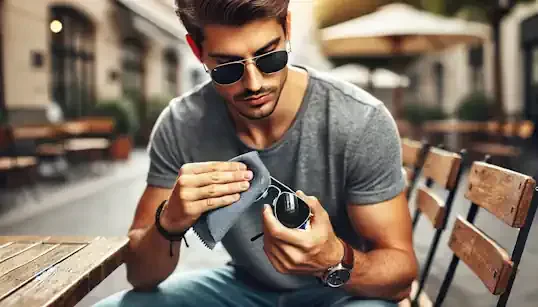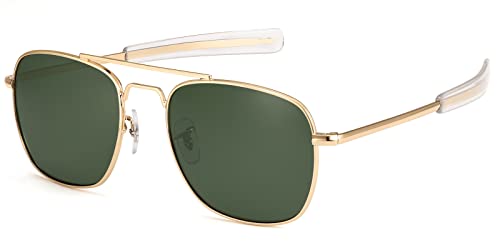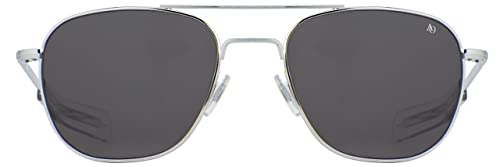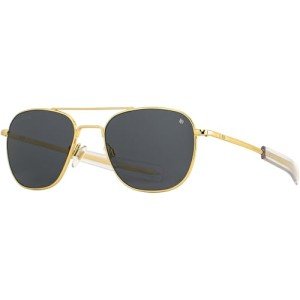Imagine the glint of sunlight catching the polished metal of perfectly maintained frames, the confident silhouette of aviator sunglasses effortlessly completing a look. There’s an undeniable allure to aviators, isn’t there? These aren't just any sunglasses; they represent a legacy of cool, a timeless style that has endured through decades, from daring pilots soaring through the skies to silver screen icons embodying effortless charisma. What other eyewear style so perfectly encapsulates both rugged functionality and refined sophistication? Aviator sunglasses, born from necessity and embraced by style icons, transcend fleeting trends. They are a considered choice, often reflecting an appreciation for quality and an understanding of enduring style. And it's precisely because they represent this investment, both financially and aesthetically, that understanding how to properly care for them becomes not just practical, but essential. This isn’t merely about wiping away smudges; it's about preserving a piece of iconic style, ensuring that your aviator sunglasses not only continue to perform flawlessly but also maintain the very essence of their enduring appeal for years to come. Consider this your comprehensive guide to cleaning and maintaining your classic aviator sunglasses, not just for today, but for a lifetime of impeccable style.
Why dedicate precious time to the meticulous care of a pair of sunglasses? For many, sunglasses are simply accessories, easily replaced when scratched or lost. But aviators, particularly those crafted with quality materials, often represent a different kind of purchase. They are an investment in craftsmanship, in timeless design, and frequently, in superior lens technology designed to protect your vision. Caring for your aviators is, at its core, protecting this investment. Think of it in practical terms: frequent replacement of lower-quality items is not only more costly over time but also contributes to a disposable culture that many are actively moving away from. Choosing quality and committing to its upkeep is a financially sound and environmentally conscious approach. Maintaining your aviators extends their lifespan, meaning you're not only saving money in the long run but also reducing waste.
Beyond the purely practical, however, lies the realm of style itself. Aviator sunglasses derive much of their iconic status from their pristine, polished appearance. Scratched lenses, tarnished frames, or loose screws are not just signs of wear and tear; they actively detract from the polished image aviators are meant to project. Imagine a meticulously tailored suit paired with scuffed shoes - the impact is diminished. Similarly, impeccably maintained aviators enhance your overall style, conveying a sense of attention to detail and refined taste. Cleanliness and proper maintenance are direct contributors to maintaining the “cool” and “polished” image aviators are so renowned for. They speak volumes about your personal style philosophy. Furthermore, proper care ensures the continued functional performance of your aviators. Clean lenses provide clearer vision, reducing glare and optimizing eye protection. This isn't just about aesthetics; it's about ensuring the very purpose of sunglasses – safeguarding your eyes – is consistently fulfilled. Maintenance goes beyond lens cleanliness, encompassing the overall fit and comfort of the sunglasses. Loose screws, bent frames, or ill-fitting nose pads can lead to discomfort, headaches, and even increase the risk of accidental damage. Regular maintenance ensures your aviators remain comfortable to wear and function as intended, providing optimal visual clarity and protection.
And for some, aviators transcend mere accessories; they become imbued with sentiment. Perhaps they were a gift, or a treasured purchase commemorating a milestone, or even a pair passed down through generations. In such cases, care takes on an added dimension. Maintaining these aviators becomes a way of preserving memories, honoring relationships, and connecting with a personal history. The gentle act of cleaning and maintaining them becomes a ritual of appreciation, extending beyond the object itself to encompass the emotional value they represent. Ultimately, caring for your classic aviator sunglasses is an act of intentionality. It’s about recognizing the value – be it financial, aesthetic, functional, or sentimental – and actively taking steps to preserve it. It's a conscious decision to invest in longevity, to appreciate quality, and to cultivate a style that is both timeless and enduring.
The cornerstone of aviator care is gentle cleaning. Just as regular skincare is essential for healthy skin, consistent cleaning forms the foundation of sunglass longevity. The frequency of cleaning depends largely on usage. For everyday wear in relatively clean environments, a light daily cleaning is beneficial, perhaps supplemented by a more thorough weekly clean. However, “clean as needed” should be the guiding principle. If your aviators have been exposed to sweat during exercise, accumulated dust during outdoor activities, or encountered fingerprints and smudges throughout the day, cleaning becomes immediately necessary. Waiting too long allows grime to accumulate, potentially making it harder to remove and increasing the risk of scratches during the cleaning process.
To properly clean your aviators, you need the right tools and materials. Foremost among these is the microfiber cloth. This seemingly simple item is the essential tool for sunglass care, and for good reason. Microfiber is specifically designed to lift dirt and oils without scratching delicate lens surfaces. It’s crucial to use a clean, dry microfiber cloth dedicated solely to cleaning your sunglasses. Avoid using the same cloth for other cleaning tasks, as it can accumulate abrasive particles. When using a microfiber cloth, employ gentle, circular motions, applying minimal pressure. Think of it as lightly dusting the lenses, rather than scrubbing them.
While a microfiber cloth is often sufficient for daily dust and fingerprint removal, a quality lens cleaner can significantly enhance the cleaning process. A good lens cleaner effectively dissolves grime, removes stubborn oils and fingerprints, and often incorporates anti-static and anti-fog properties. When selecting a lens cleaner, opt for those specifically formulated for eyewear. Alcohol-free cleaners are generally recommended, especially for lenses with specialized coatings like anti-reflective or scratch-resistant layers, as alcohol can potentially degrade these coatings over time. Apply lens cleaner sparingly, spritzing a small amount onto the microfiber cloth, never directly onto the lenses themselves. Then, gently wipe the lenses clean using the same circular motions.
For deeper cleans, particularly when dealing with grease, sunscreen residue, or stubborn grime, mild soap and water offer a safe and effective solution. Use lukewarm water – never hot, as extreme temperatures can damage certain lens materials or frame components. Select a truly mild soap, such as a diluted dish soap free of harsh chemicals or abrasives. Apply a tiny amount of soapy water to your fingertips and gently cleanse the lenses and frames. Crucially, rinse thoroughly with lukewarm water to remove all soap residue. Soap left to dry can leave streaks or a film on the lenses. After rinsing, gently pat dry with a clean microfiber cloth. Allow the sunglasses to air dry completely before storing them, ensuring no moisture remains in hinges or crevices.
Conversely, it’s equally important to understand what to avoid when cleaning your aviators. Harsh chemicals are a definite no-no. Household cleaners, window cleaners, harsh soaps, or alcohol-based wipes are far too aggressive for delicate lens coatings and frame materials. These substances can strip away protective coatings, damage lens tints, and even corrode metal frames. Similarly, paper products like paper towels, tissues, or napkins should be avoided at all costs. While seemingly soft, these materials contain wood fibers that are surprisingly abrasive to lenses. Using them can result in microscopic scratches over time, gradually diminishing lens clarity and potentially impacting vision. Finally, rough handling is detrimental. Avoid aggressive rubbing or scrubbing, regardless of the cleaning method. Excessive pressure can scratch lenses and potentially damage frames, especially delicate metal components. Gentle, patient cleaning is always the best approach. By adhering to gentle cleaning methods and avoiding harmful substances and techniques, you establish the essential foundation for preserving your aviator sunglasses for years to come.
Cleaning is just the first step; proactive maintenance is the ongoing commitment that ensures true longevity. Proper storage is paramount when your aviators are not adorning your face. Cases are not merely accessories; they are essential shields against the everyday hazards that can damage your sunglasses. A hard case offers the ultimate protection, safeguarding against scratches, impacts, and crushing. Whenever your aviators are not in use, they should reside in their hard case. Soft pouches can serve as a convenient backup for quick storage, offering a degree of protection from scratches when a hard case isn’t readily available. However, soft pouches offer minimal protection against impacts or pressure, making them less ideal for long-term storage.
Equally important is storage location. Never leave your sunglasses exposed to extreme temperatures or direct sunlight for extended periods. Hot cars, in particular, become veritable ovens, reaching temperatures that can damage frames, distort lenses, and even degrade lens coatings. Direct sunlight can also fade frame colors and potentially warp delicate materials over time. Opt for cool, dry storage locations whenever possible, such as a drawer, a closet, or a shaded bag. Careful handling during use is equally crucial. Develop the habit of using two hands to put on and take off your sunglasses. This simple practice minimizes stress on the frames, preventing bending, loosening of hinges, and potential breakage. Resist the common temptation of resting sunglasses on your head when not in use. This seemingly innocuous habit can stretch frames over time, loosen hinges, and increase the risk of them falling off and getting damaged. Furthermore, be mindful of where you place your sunglasses when you take them off. Avoid placing them lens-down on surfaces, as this directly exposes the lenses to scratches. Always place them lens-up or, ideally, directly into their case or pouch.
Regular inspection is another proactive step in maintenance. Periodically check the small screws on the frames, particularly around the hinges and nose pads. Gentle tightening with a small screwdriver (often included with eyewear repair kits) can prevent screws from loosening and potentially falling out. Nose pads, being in constant contact with skin, accumulate sweat, oils, and debris. Clean nose pads regularly using a mild soap and water solution or specialized eyewear cleaning wipes. If nose pads become worn, discolored, or detached, replacement nose pads are readily available and easily installed, often significantly improving comfort. Frame alignment is also worth checking periodically. Lay your sunglasses on a flat surface. If one temple arm doesn't sit flush with the surface, or if the frame appears visibly bent, it indicates misalignment. Minor misalignment can sometimes be gently corrected, but significant bends require professional adjustment from an optician to avoid further damage.
Lens protection extends beyond cleaning and scratch prevention. While quality aviator lenses typically offer robust UV protection, it's worth being aware that UV protection, although durable, can theoretically degrade very gradually over decades, particularly in extremely harsh UV environments. While unlikely to be a significant concern for most quality aviators within their functional lifespan, it’s a factor to keep in mind for sunglasses that are truly decades old. Scratch prevention remains paramount. Reiterate the importance of avoiding abrasive materials and rough surfaces. Consider the benefits of lens coatings. When purchasing new aviators or considering lens replacements, explore options like scratch-resistant and anti-reflective coatings. Scratch-resistant coatings provide an added layer of defense against everyday wear and tear, while anti-reflective coatings reduce glare and enhance visual clarity, further improving both performance and longevity. By incorporating these proactive maintenance practices into your routine, you are not just cleaning your aviators; you are actively safeguarding their structure, functionality, and overall style for the long haul.
Even with the most diligent care, certain issues may arise over time. Scratches, unfortunately, are sometimes unavoidable, particularly with everyday wear. Minor surface scratches may appear superficial, but it’s important to acknowledge that effective DIY scratch removal is often limited, and can even worsen damage. Numerous online remedies and scratch removal products exist, but many are ineffective and some can actually further scratch or damage lens coatings. For significant scratches that impact vision or are aesthetically bothersome, professional lens polishing or lens replacement are the most viable options. Professional polishing can sometimes minimize minor scratches, but deeper scratches often require lens replacement to restore optimal clarity. It's important to have realistic expectations – some scratches are, unfortunately, permanent, especially those that penetrate deeply into the lens material.
Bent frames and loose hinges are other common issues. Gentle handling, as emphasized previously, is the best prevention. However, accidents happen. For minor bends, particularly in flexible metal frames, gentle manipulation might be possible, but it's generally discouraged to attempt DIY bending. Excessive force can easily lead to breakage. For bent frames or loose hinges, seeking professional adjustment from an optician is the safest and most effective approach. Opticians have specialized tools and expertise to realign frames and tighten hinges without causing further damage.
In situations where parts become damaged beyond repair, or simply wear out, consider replacing components rather than discarding the entire pair of sunglasses. Nose pads and temple tips are frequently replaceable and readily available. Even lenses, in many aviator styles, can be replaced if significantly scratched or damaged. Contacting the manufacturer or a reputable eyewear repair service is the best course of action for sourcing replacement parts and ensuring proper installation. Knowing when to seek professional help is key. For significant scratches, bent frames, loose hinges that cannot be easily tightened, or any complex repairs, consulting a professional is always advisable. A reputable optician or eyewear repair specialist possesses the necessary expertise and equipment to address these issues effectively and safely, preserving the integrity of your aviator sunglasses.
Taking a few moments regularly for cleaning and practicing proactive maintenance may seem like a minor effort, but the cumulative effect is substantial. It's the consistent, gentle care that significantly extends the life, maintains the performance, and preserves the iconic style of your aviator sunglasses. Investing this small amount of time safeguards your initial investment, ensures continued visual clarity and eye protection, and, crucially, allows you to enjoy the timeless aesthetic of your aviators for years to come. By adopting these cleaning and maintenance tips as a regular routine, you are making a conscious choice to appreciate quality, embrace longevity, and cultivate a style that is both classic and enduring. So, take a moment now, gather your microfiber cloth and lens cleaner, and give your aviators the care they deserve. They will, in turn, continue to shield your eyes, elevate your look, and remain a testament to your discerning taste for many years to come. Your classic aviators, meticulously cared for, become more than just sunglasses; they become a lasting style companion, a symbol of enduring cool, and a personal statement of timeless elegance.







